Royal Australian Air Force C-130Js and C-27Js are flying evacuation and relief missions in skies turned red above parts of southeast Australia.
The following images show the extremely challenging flying conditions faced by RAAF C-130J Super Hercules and C-27J Spartan flying missions in New South Wales and eastern Victoria, to support the firefighting and evacuation activities following the deadly bushfires that are burning across Australia.
As the fly through the heavy smoke, the cargo aircraft have their cockpit lit by the red glow of the fires. According to the RAAF, the videos were filmed on Jan. 4, 2020, as C-130Js attempted to land at Merimbula to bring Fire and Rescue crews from the Mid-North Coast while C-27J Spartan crew attempted landing at Mallacoota to carry out an evacuation. Landing at such small airfields with visibility degraded by smoke generated from bushfires is not an easy task.
Our people are highly trained & professional, but not always able to complete the mission on first try.
This video shows how heavy smoke from bushfires has prevented some C27J & C130J flights from reaching #Mallacoota & #Merimbula #AusAirForce #AustralianFires #YourADF pic.twitter.com/PhNjNIUVHf
— Air Commander (@RAAF_ACAUST) January 6, 2020
Photographs coming from New South Wales, show an eerie, smoke-filled landscape illuminated by a blazing red sky. It looks like a Mars scenario.

A total of 146 fires are burning across NSW according to the NSW Rural Fire Service (NSWRFS). More than 5.25 million hectares (13 million acres) of land have been burnt so far in this fire season across Australia and nearly 1,500 homes have been destroyed in New South Wales alone.
The Australian Defence Force (ADF) has launched Operation Bushfire Assist 19-20 and has stood up Joint Task Forces in New South Wales and Victoria to enhance Defence support following devastating bushfires in the South East of Australia.

Along with the RAAF C-27Js and C-130Js, that provide transport, MEDEVAC and other firefighting support, HMAS Choules and MV Sycamore sailed from Sydney and operate off the Southern NSW/North East Victorian coast to provide support to communities cut off due to the bushfires. MRH-90 helicopters of the Royal Australian Navy have also been dispatched to support Operation Bushfire Assist.

Qantas canceled all flights to and from the country’s capital, Canberra, on Sunday due to smoke and hazardous weather conditions. In fact, the bushfires are are generating thunderstorms and fire tornadoes: in other words, they are generating their own weather.
Pyrocumulonimbus clouds (i.e. thunderstorms formed from the smoke plume of a fire) have started to appear.
Pyro-cumulonimbus clouds have developed to altitudes over 16km in East #Gippsland this afternoon. These fire-induced storms can spread fires through lightning, lofting of embers and generation of severe wind outflows #VicWeather #VicFires pic.twitter.com/gZN6sC7meU
— Bureau of Meteorology, Victoria (@BOM_Vic) December 30, 2019
Pyrocumulonimbus clouds are created by the intense heat from the fire that causes air to rise rapidly. As it ascends, the air cools and condenses causing a cloud to form.
“As the cloud climbs and then cools in the low temperatures of the upper atmosphere, the collisions of ice particles in the higher parts of the cloud build up an electrical charge, which can be released as lightning,” Melanie Burton reported for Reuters. “These can cause dangerous and unpredictable changes in fire behavior, making them harder to fight as well as causing lightning strikes that could ignite new fires. The rising air also spurs intense updrafts that suck in so much air that strong winds develop, causing a fire to burn hotter and spread further.”










